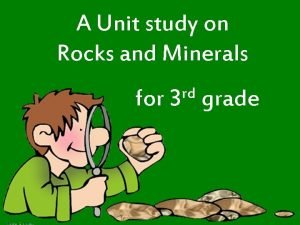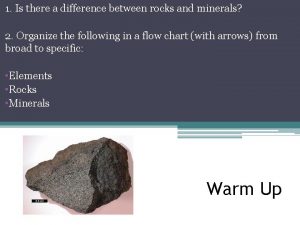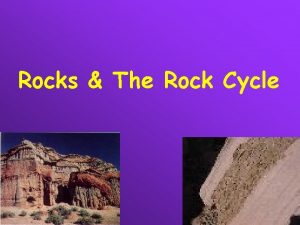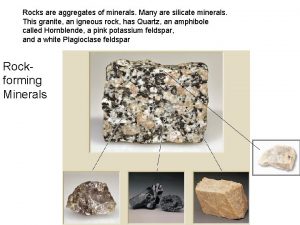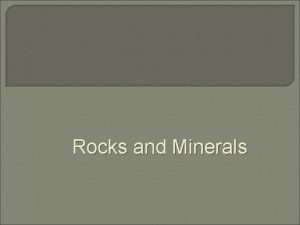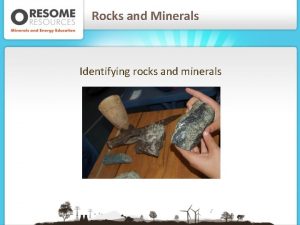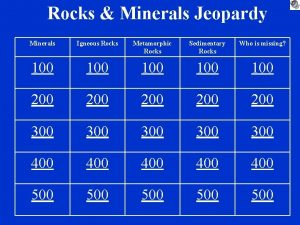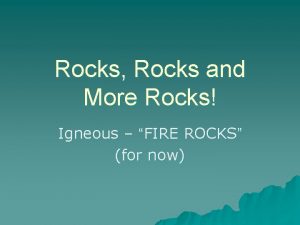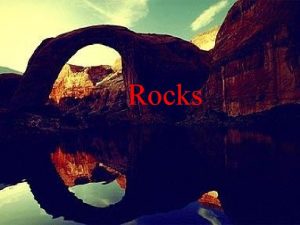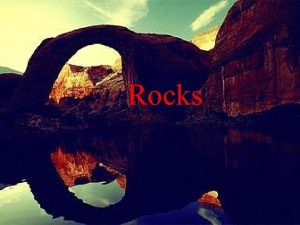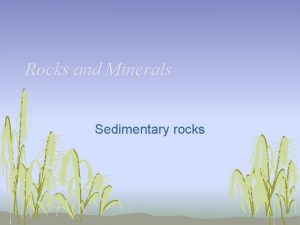Rocks and Minerals Notes Minerals n Minerals make












- Slides: 12

Rocks and Minerals Notes

Minerals n Minerals make up rocks. n They are natural occurring inorganic crystalline structures n Scientists identify minerals based on their physical properties.

Physical Properties of Minerals n Hardness (how easy it can be scratched) n Color- (appearance in reflected or transmitted light) n Luster (how it interacts with light - shiny – metallic or dull non metallic or glassy vitreous) n Streak (color of mark it leaves behind on a streak plate)

Mohs Scale q n n Scale created by Fredrich Mohs in 1812 to compare the hardness of minerals using a scratch test. Hardness of a fingernail is 2 -3 Hardness of a penny is 35 Hardness of a glass is 5 -6 Hardness of an iron nail is greater than 6 http: //instrumentarmor. com/wpcontent/uploads/2009/09/Mohs-Scale. png

Processes that form rocks: n n n n Melting: Heating in the Earth causes rocks to melt forming magma (melted rock beneath the Earth’s surface). Cooling & Hardening: Magma rises to the surface, cools and hardens. Weathering, Erosion and Deposition: Weathering breaks down rocks into sediment. Erosion is the movement of that sediment. Deposition is the process where the sediment is dropped off.

Processes that form rocks: n n n Compacting & Cementing: Cementation is when sediments are glued together to form a rock. Pressure packs sediment together, cementing minerals together. Compaction is when sediments are pressed together through pressure Heat & Pressure: Heat from magma and pressure from overlying rock squeezes minerals changing rocks.

Types of Rocks Igneous Rock Forms from magma or lava (melted rock on the Earth’s surface), melted rock. Granite Diorite n n When it cools above ground it cools faster forming extrusive igneous rock (ex. granite). When it cools underground, it cools slower, forming intrusive igneous rock Pumice Obsidian

Types of Rocks n Sedimentary Rock n Formed from sediment that has become compacted and cemented together. Sediments are small pieces of material broken off rocks. When rocks are deposited in layers and they are compacted and cemented together, they form strata (a layered/striped look). Examples - Limestone, conglomerate and sandstone. n n n Conglomerate http: //www. physicalgeography. net/fundamentals/10 f. html Sandstone

Types of Rocks n Metamorphic Rock Form from other rocks being heated and put under pressure. n Rocks undergo metamorphosis, not melting. n Example - Marble n http: //www. physicalgeography. net/fundamentals/10 f. html Gneiss Marble


http: //www. victoria-sponge. com/media/ROCK%20 CYCLE%20 diagram%20 websm. jpg

http: //rst. gsfc. nasa. gov/Sect 2/rock_cycle_800 x 609. jpg
 Igneous rock to metamorphic rock
Igneous rock to metamorphic rock Igneous metamorphic and sedimentary
Igneous metamorphic and sedimentary Types of rocks
Types of rocks Solid rock
Solid rock Difference between minerals and rocks
Difference between minerals and rocks Concept map igneous rock
Concept map igneous rock Poem about minerals and rocks 3 stanza
Poem about minerals and rocks 3 stanza Difference between rock and stone
Difference between rock and stone Rock type
Rock type Intrusive vs extrusive igneous rocks
Intrusive vs extrusive igneous rocks Granite diorite gabbro
Granite diorite gabbro Minerals vs rocks
Minerals vs rocks Rocks are aggregates of minerals
Rocks are aggregates of minerals




